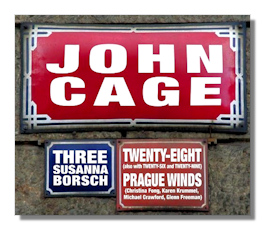
The Internet's Premier Classical Music Source
Related Links
- Cage Reviews
- Latest Reviews
- More Reviews
-
By Composer
-
Collections
DVD & Blu-ray
Books
Concert Reviews
Articles/Interviews
Software
Audio
Search Amazon
Recommended Links
Site News
 DVD-Audio Review
DVD-Audio Review
John Cage

Number Pieces
- Three (1989) 1
- Twenty-Eight (1991) 2
- Twenty-Six with Twenty-Eight (1991) 3
- Twenty-Eight with Twenty-Nine (1991) 4
1 Susanna Borsch, recorders
Christina Fong, violins3 & violas4
4 Karen Krummel, cellos
4 Michael Crawford, double basses
4 Glenn Freeman, percussion & bowed piano
2,3,4 Prague Winds
OgreOgress 634479754012 DVD-Audio 96kHz/24-bit LPCM Stereo 122:00
Here come more of John Cage's number pieces from OgreOgress, described as "Michigan's Classical-Experimental Label." The number pieces, which come from the last five years of Cage's life, are named for the number of performers they require. Three, for example, requires three performers, all of them playing a variety of recorders. Sometimes there is a number in superscript. Three2, for example, would be the second number piece written for three performers. Most of these scores are made up of individual notes or small groupings of notes, with an indication of when each note or grouping should begin and end, within the context of the entire piece.
As stated, Three is scored for three recorder players, although only one player is credited by OgreOgress, so I assume that over-dubbing has been used to triple Ms. Borsch. (And how would Cage have felt about that?) This piece actually requires 15 recorders, from the sopranino recorder down to the double bass recorder, so even live, a lot of instrument switching must occur. Three opens with a movement that lasts for 6:45, and then there are nine sections, marked A through I, each of them three minutes long. Cage specifies that "one or any number of these" may be played between the first and the last movement, whose timing here is 3:39. Borsch elects to play all of them, and so the work's total timing is 37:24. The music is pointillistic; often there's a note, then silence, then another note, and so on. Obviously this will be frustrating for listeners who feel that music should be overtly purposeful and linear. Other listeners will simply integrate Three into whatever else they happen to be doing, or not doing, at the time. Borsch's tone is very straight and clinically recorded, so it isn't always clear whether she is playing recorders or an organ (or perhaps a calliope). I wonder how Cage would have felt about that too!
Twenty-Eight is scored for three flutes, one alto flute, four clarinets, three oboes, one English horn, three bassoons, one contrabassoon, four trumpets, four French horns, two trombones, one bass trombone, and one tuba. Only eight performers are listed within the Prague Winds, so again, over-dubbing must have been used. With more performers, the texture is thicker than in Three, but not by as much as you might expect. It continues for 28 minutes and then stops.
Things get more interesting when Twenty-Eight is combined with two earlier number pieces, Twenty-Six and Twenty-Nine. ("Twenty-Six with Twenty-Eight" sounds a bit like an order in a Chinese restaurant!) Cage specified that some of his music could be played simultaneously, and that is exactly what happens in these two last cases. Well, not "exactly," because I think the simultaneity has occurred after the fact, if you will. In other words, OgreOgress already has recordings of Twenty-Six (for 26 violins) and Twenty-Nine (for two timpani, two percussionists, bowed piano, ten violas, eight cellos, and six double basses) in its catalog, and I believe that they were combined in the studio with the new recording of Twenty-Eight. And I wonder how Cage would have felt about that?
Be that as it may, these two combination pieces have a powerful impact, particularly the second, which is as sad as a frozen nuclear wasteland. (That's pretty much what I wrote about Twenty-nine all by itself, when I reviewed that OgreOgress release on Classical Net.) In Twenty-Six with Twenty-Eight, the use of violins brightens the textures, but it does not necessarily lighten them. In Twenty-Eight with Twenty-Nine, the lower strings (and the bowed piano strings) lower the temperature to near zero … make that zero degrees kelvin. I think of this as Cage's version of the last movement of Bruckner's Ninth Symphony. Tremendous! The playing in all of these works is ego-free but not disconnected.
The recording is clear but cold, and innocent of anything resembling a realistic sonic perspective. I think that's beside the point anyway. Reality is terribly overrated!
This audio DVD is available from Amazon.com and cdbaby.com.
Copyright © 2009, Raymond Tuttle




















